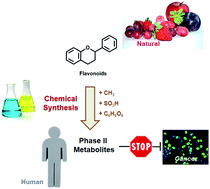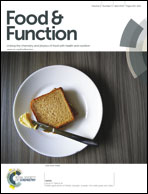Anti-proliferative effects of quercetin and catechin metabolites
Abstract
Dietary flavonoids have been associated with a lower incidence of some chronic diseases. However, the mechanisms behind the in vivo biological activity of flavonoids are still mostly unknown. Flavonoids are metabolized in the human body to conjugated forms (methylated, sulphated and glucuronidated derivatives) that should play a role in flavonoid activity. In this study, the anti-proliferative effects of conjugated metabolites of quercetin and (epi)catechin, major flavonoids in the diet, have been evaluated against three different cancer cell lines from breast (MCF-7), colon (Caco-2) and pancreas (BxPC-3) and one normal cell line of human foreskin fibroblasts (HFF-1), and compared with the effect of their unconjugated forms. Quercetin showed anti-proliferative activity on the three assayed cell models, whereas catechin and epicatechin were not active. Methylation on ring-B of quercetin decreased the anti-proliferative effects, especially when the methylation occurred in position 3′ (isorhamnetin), although methylated metabolites still showed significant anti-proliferative activity. As to catechins, 4′-O-methyl-epicatechin and 3′-O-methyl-epicatechin were the only ones to show some activity on MCF-7 and BxPC-3 cell lines, respectively. Conjugation of quercetin with glucose or glucuronic acid eliminated the anti-proliferative effects of aglycones. Sulphated metabolites were also tested and found to be inactive in most of the explored cell lines, although quercetin-4′-O-sulphate and epicatechin-3′-O-sulphate still showed some anti-proliferative activity on MCF-7 and Caco-2 cells, respectively.


 Please wait while we load your content...
Please wait while we load your content...